Plants
Updating Plants on the GC & E
Sep 3, 2003


By Randy Mower |
Author
Bio
Plants get planted and plants grow. Learn now to save time by picking the plants that grow slow and require less time to prune.
|
When starting out building a garden railroad a builder is usually most concerned about getting track down, acquiring rolling stock and buildings. If a layout is not being built in an established garden where the builder is trying to include existing plants a new builder often overlooks being particular about the plants he/she purchases. Hence people often take the easy way out and pick up inexpensive plants like Dwarf Alberta Spruce or Boxwoods at the local Lowe's or Home Depot. I was no different when I started building my GC & E Railway in 1992. I preferred to spend my limited budget on track, and cars and a few buildings and got the "cheap" plants on sale at Hechinger's (remember them) or Lowe's.
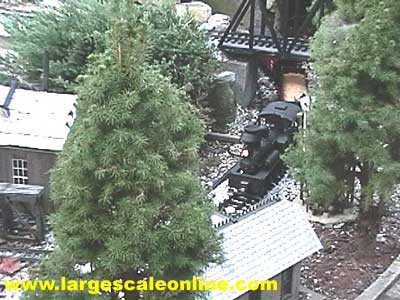
The Dwarf Alberta Spruce and Creeping Junipers have gotten too large to be in scale anymore in the town of Webster Springs on the GC & E.
While these "semi-dwarf" plants looked good for a number of years after about 5- 7 years the Dwarf Spruce start getting too big to look in scale anymore. I've tried pruning, but I just don't seem to have the knack for bonsai pruning them. I have had more luck with the boxwoods though and have been able to keep them in scale with judicious pruning (mostly taken care of by my wife Sharon).
One of the members of the Susquehanna Valley Garden Railways society runs a nursery called Appalachian Gardens, which specialized in miniature plants suitable for the garden railway. Recently, I had an opportunity to purchase some plants from them at our clubs annual picnic (after some prodding from Sharon) I picked up five plants in three varieties to replace some of my overgrown Alberta Spruce and Creeping Junipers. In reality, these little plants are not really that much more expensive than the ones you get at the home stores, with most varieties being under $10.00 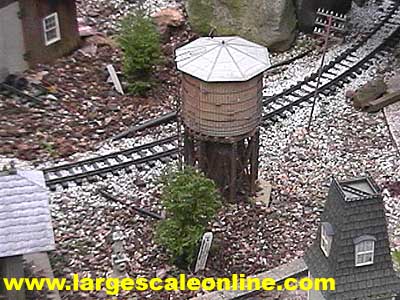
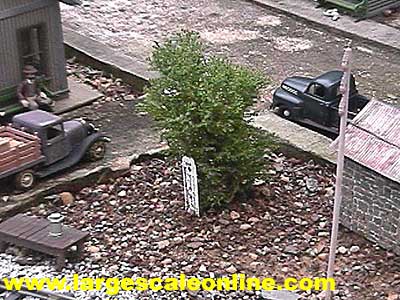
I got three small Cypress called CHAMAECYPARIS obtuse "Sanderi" or Sander's Hinoki Falsecypress. These miniature plants grow to a maximum of 3' high and 30" diameter. I used these trees to replace two Dwarf spruce on both sides of my station in Webster Springs and I put one where I had a creeping juniper that had gotten much too large next to my engine shed.
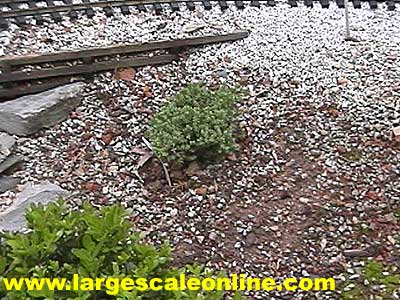
Along the embankment along the right of way at the right side of the town I had another Creeping Juniper that had gotten too large. I dug it out and replaced it with a JUNIPERUS procumbens "nana" or Japanese Garden Juniper. This little Juniper gets a maximum height of 12" with a 4-6' spread. 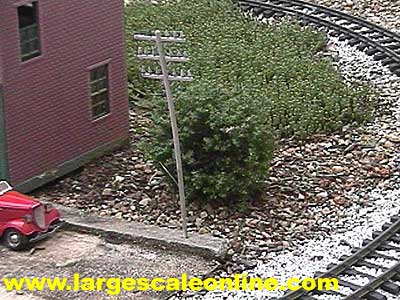
Finally, I purchased one more cypress called CHAMAECYPARIS obtuse "Blue Feathers" or Blue Feathers Falsecypress. This little gem grows to a maximum of 18-24" high with a 24" spread. I placed this little guy next to one of my brick stores at the end of the street. All of these varieties of plants are very slow growing and they will take years and years to reach their maximum sizes. Now I can look forward to less pruning at the south end of the railroad.
If you do decide to take the approach of using less expensive and common plants initially, one thing that can help is keeping the plants in the pots when you plant them. It will slow the growth a little and it will make them easier to dig them out when if you decide to replace them later on. By the time the plants mature to the point they are too large you may be ready to replace them with more "scale" plants. Next year I am planning to expand the GC & E and rework about 1/3 of the north end of the layout, when I do I am planning to plant more of these slow growing miniature plants to help keep everything in scale and reduce our pruning work. 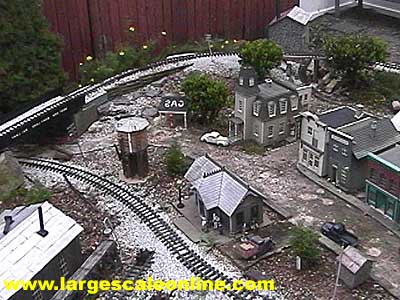
In this "after" photo the dwarf plants are shown in their new locations throughout the town of Webster Springs. Appalachian Gardens has a catalog available complete with silhouettes of the plant shapes and descriptions. They can be contacted (717)762-2030 Top of Page
|



